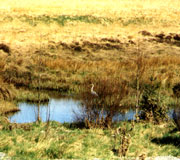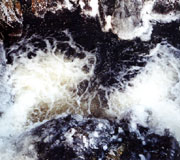 |
Galloway Fisheries
Trust ~ Kirkcudbrightshire Dee Report |
|
| |
 |
|
|
|
|
|
|
|
|
|
|
|
|
 |
 |
 |
 |
 |
 |
 |
 |
 |
 |
 |
 |
 |
 |
 |
 |
| |
The Kirkcudbrightshire
Dee is one of the largest river catchments in South West Scotland (1021
km2) and was, in the past, one of the major salmon fishing rivers in
Scotland. However, catches have been perceived to be in decline. There
are a number of factors which may contribute to this decline in salmonid
numbers, which has also been reflected throughout many other West coast
catchments. Although marine mortality is thought to be the principal
contributory factor in the decline of these salmon stocks, the GFT have
identified several other issues which are occurring to varying extents
within the catchment of the Kirkcudbrightshire Dee.
|
|
|
|
 |
|
|
|
|
|
|
|
|
|
|
|
|
|
|
|
| |
|
|
Acidification
~ The GFT has concerns that parts of the Kirkcudbrightshire Dee catchment
are suffering from acidification. The Water of Deugh and the Black Water
of Dee are particularly vulnerable to low pH levels and have requently
failed to meet the pH requirements for salmonids of the EC Freshwater
Fisheries Directive. However, further downstream, the underlying geology
alters to that of calciferous Silurian rocks, which helps to raise the
pH values and reduce the resultant acidification problems. Acidification
of these watercourses is aggravated by the presence of blanket coniferous
plantations. During 1990, approximately 34% of the total catchment area
was under forestry cover (Young, 1996). However, many sub-catchments
have been more extensively planted. These plantations act as scavengers
of airborn pollutants and, combined with a poorly buffering underlying
geology, aggravate the low pH levels in some areas.
|
|
 |
|
|
|
|
|
|
|
|
|
|
|
|
|
|
|
| |
High levels of acidity
are extremely detrimental to aquatic life. It is known for example that
at levels of below pH 5.6, salmonid eggs fail to hatch, due to the inactivation
of an enzyme required for hatching. This obviously has strong implications
for the sustainability of the salmonid populations in some areas. However,
acid emissions are falling and international agreements have been reached
which should see the continued decline of this source of pollution.
Furthermore, forestry interests now consult widely on new development
plans. Despite these developments, it is likely to be some time before
the acidification problems within some areas of the Kirkcudbrightshire
Dee catchment begin to recover.
|
|
|
|
 |
|
|
|
|
|
|
|
|
|
|
|
|
|
|
|
| |
|
|
Hvdro-Electric Schemes
~ On the 10th May 1929, Parliament passed the Galloway Water Power Act
(1929), which allowed the progress of the Galloway Hydro-Electric Scheme.
The scheme incorporates the entire catchment of the River Dee and also
the upper reaches of the River Doon, through the damming of Loch Doon.
Through electro-fishing surveys, the WGFT have shown that the fish passes
at Tongland, Earlstoun and Carsfad do allow salmon to access areas upstream
of each dam. However, concerns exist that, particularly at the Tongland
pass, adult fish are not always easily able to locate the entrance to
the pass and exit the upper chambers. The fish are also particularly
vulnerable to poachers in this area. Furthermore, there are concerns
that kelts and smoults find it difficult to progress downstream through
the Tongland Dam. Scottish Power, together with the WGFT, the KDDSFB
and others are currently investigating methods which would allow improved
access to migratory salmonids on their joumeys upstream and downstream.
|
|
 |
|
|
|
|
|
|
|
|
|
|
|
|
|
|
|
| |
Habitat Degradation
~ During previous years, the GFT have habitat
surveyed a number of tributaries of the Kirkcudbrightshire Dee. The
purpose of these surveys is to identify areas which suffer from habitat
degradation and would benefit from specific remedial measures. Degradation
of habitat may take many forms. It is essential that ascending spawning
fish can run unhindered up tributaries, to utilise available spawning
habitat. Obstacles may take many forms, such as natural obstructions,
e.g. waterfalls and man-made obstructions, such as dams. Additionally,
debris may accumulate against some forms of obstruction and result in
severe bankside erosion, as the watercourse attempts to find an alternative
route around the obstacle.
|
|
|
|
 |
|
|
|
|
|
|
|
|
|
|
|
|
|
|
|
| |
 |
|
There are various methods
by which the diversity and quantity of suitable habitat can be restored
within a degraded watercourse. Rock placement instream will create small
pools and riffles and can also be used to provide bankside fish cover.
The insertion of stone weirs and deflectors will redirect flows and
encourage pool and riffle sequences. Willow wands placed into bankface
and bankside will quickly grow and, in addition to helping to stabilise
the banks, will provide cover for fish and contribute woody debris to
the instream environment. Too many bankside trees can result in overshading
of the watercourse. The resultant lack of light can limit primary production
and cause a consequent lack of food for salmonids. Cutting back or coppicing
these trees will allow greater light penetration through the canopy.The
GFT, working in partnership with the D(K)DSFB, are currently undertaking
a three year bankside and instream habitat improvement project to help
address the problems of degraded habitat. This work will be partially
funded by Scottish Natural Heritage.
|
|
 |
|
|
|
|
|
|
|
|
|
|
|
|
|
|
|
| |
Signal Crayfish
~ The signal crayfish is not a native species within Scotland. However,
they were introduced into the Dee in the belief that they would supplement
the native fisheries. The Signal Crayfish is a voracious carnivore and
will feed on salmonid fry and parr. While the crayfish may be preyed
upon itself by salmon and trout whilst it is moulting and therefore
vulnerable to attack, this occurs during limited periods of time. Additionally,
the crayfish resides under stones, amongst roots and under overhanging
banks, which brings it into direct competition with fish, especially
1+ individuals, for shelter and cover.
|
|
|
|
 |
|
|
|
|
|
|
|
|
|
|
|
|
|
|
|
| |
 |
|
The Galloway Fisheries
Trust continue to carefully monitor the catchment of the Kirkcudbrightshire
Dee and will maintain its role in respect of both research and management
of this valuable natural resource. The GFT liases extensively with organisations
such as Forest Enterprise, Scottish Natural Heritage, the Scottish Environment
Protection Agency, Scottish Power and others. The Trust is also contributing
to the development of the Ken-Dee Catchment Management Plan, which is
being developed as a result of recommendations made by the Local Biodiversity
Action Plan. A Salmon Management Plan will also be formulated by the
GFT, which will present much of the data that the GFT possess on the
catchment and will also formulate a comprehensive strategy for its management
on a rolling five year programme.
|
|
 |
|
|
|
|
|
|
|
|
|
|
|
|
|
|
|
| |
|
|
|
|
|
|
|
|
|
|
|
|
|
|
|
 |
|
|
|
|
|
|
|
|
|
|
|
|
|
|
|

